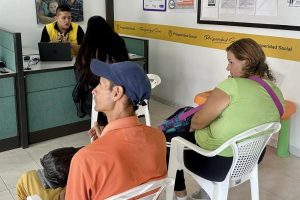The economic studies center Anif said that, based on the Credicorp Financial Inclusion Index, Colombia is located at a medium-low level compared to the rest of the countries in the
region.
Luz Magdalena Salas, vice president of Anif, assured that in access and use of financial products and services, the countries of the region show very low levels. The use of these is especially critical, with four countries below 30% and Colombia is one of them, with 26.3% in 2023.
Read: IDB launches ‘single window’ to promote financial inclusion in Latin America
The vice president of Anif commented that Colombia has made progress in terms of general financial inclusion with an indicator of 45.6 points (44.7 points in 2022) But there are challenges to overcome since the country is behind Argentina, Chile, Panama and Ecuador and surpasses Peru, Mexico and Bolivia.
He mentioned notable aspects in which Colombia and the region have advanced, such as digital wallets because of their growth and use, but also the frequency of that use. And the use of fintech and payment methods is being improved, but he pointed out that the level of savings is very low.
Read: The ‘fintech’ industry contributes to greater financial inclusion
But he asserted that in the case of women and men there is still a significant gap, as well as in rural and urban areas and with some population groups that are still excluded. “In addition to these groups, people who do not have access to the internet, adults over 60 years of age, as well as groups with a low educational level, are also highly excluded,” said Luz Magdalena Salas.
Financial inclusion
iStock
The Anif board considered that leverage and access to credit are essential to increase business productivity, but Colombia continues to lag behind in both aspects. He highlighted the fact that according to the World Bank, IDB and the Alliance for Financial Inclusion, 45% of companies have access to formal credit and a consequence of that is that according to evidence, companies experience a significant increase in productivity and operational efficiency.
Read: IDB calls for greater financial inclusion and more security
Likewise, the digitalization of financial services can reduce the operating costs of microbusinesses by up to 30% and pointed out that although a higher level of debt represents a greater financial risk, it brings benefits for companies as it is a tool to manage better the risk, uncertainty and high income volatility and warned that debt should be used as an investment mechanism to enhance growth.
They will present a new measurement of Financial Inclusion
For her part, Paola Arias, director of Banca de las Oportunidades, said that Colombia is consolidating the panorama of access to financial inclusion products. “We reached 94% in access to products, that is, 94% of adults in Colombia have a transactional product. A decade ago 50% had a product. Today a large part has a deposit product on their cell phone, a low amount deposit”he pointed.
The official recalled that wallets have helped the market a lot and the pandemic was an important catalyst for this growth since cash was a vector of contagion and the Government carried out a significant dispersion of unconditional transfer resources through these channels.

Financial inclusion
iStock
Read: The progress in financial inclusion that Colombia has made, according to Queen Máxima
He warned that this did not remain a pandemic, but that in 2022 and 2023 it deepened and that in the results of the 2024 report “the results will be presented with very important figures in low-amount deposits.”
Paola Arias said that 80% of the adult population in Colombia has a savings account but this growth has been slower than low-amount deposits in both access and use. Deposits are more used than deposit accounts.
Read: Financial inclusion, how does it help Colombians’ pockets?
The director of Banca de las Oportunidades said that 15 years ago 30% of municipalities did not have an access point to the financial system, but with the figure of banking correspondents it was possible to reach 100% of the country’s municipalities and in the Currently there are 600,000 correspondent contracts and the majority are outsourced, that is, they provide services to more than one entity.

Banks
iStock
Furthermore, he pointed out that beyond the financial inclusion figures, progress must be made in measuring the financial well-being that said financial inclusion generates and in A first approximation exercise, based on the demand survey, the score, measured from 1 to 10, yielded a measurement of 5.26.
HOLMAN RODRÍGUEZ MARTÍNEZ





![[Img #74683]](https://thelatestnews.world/wp-content/uploads/2024/12/The-main-mistakes-to-avoid-when-betting-on-electronic-sports-150x150.jpg)










Add Comment